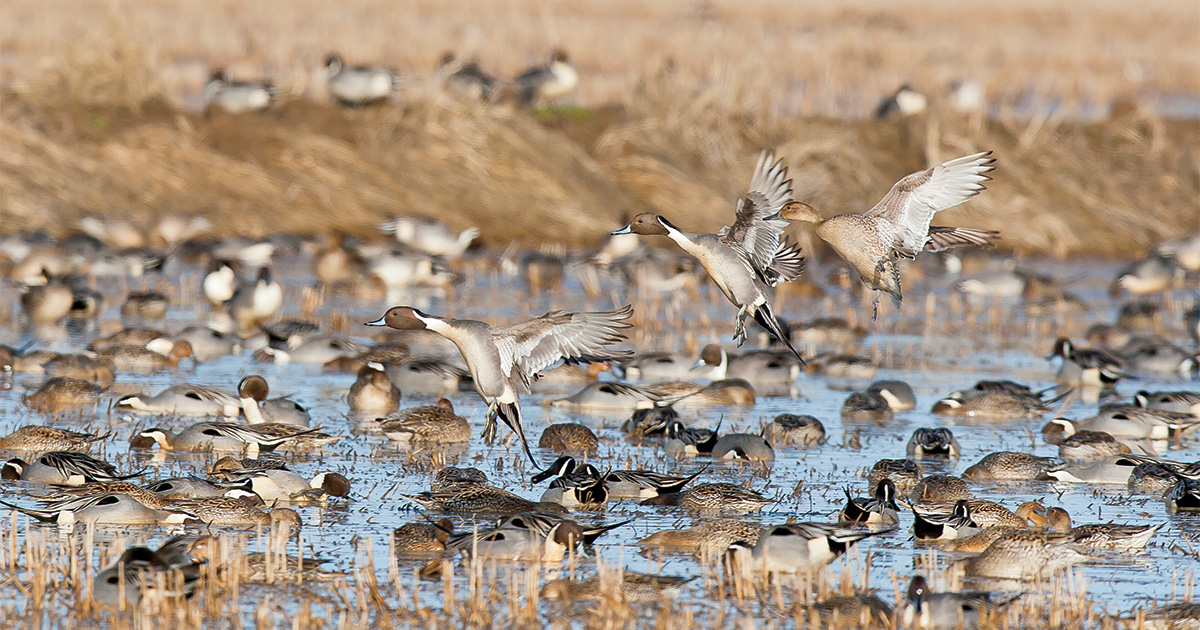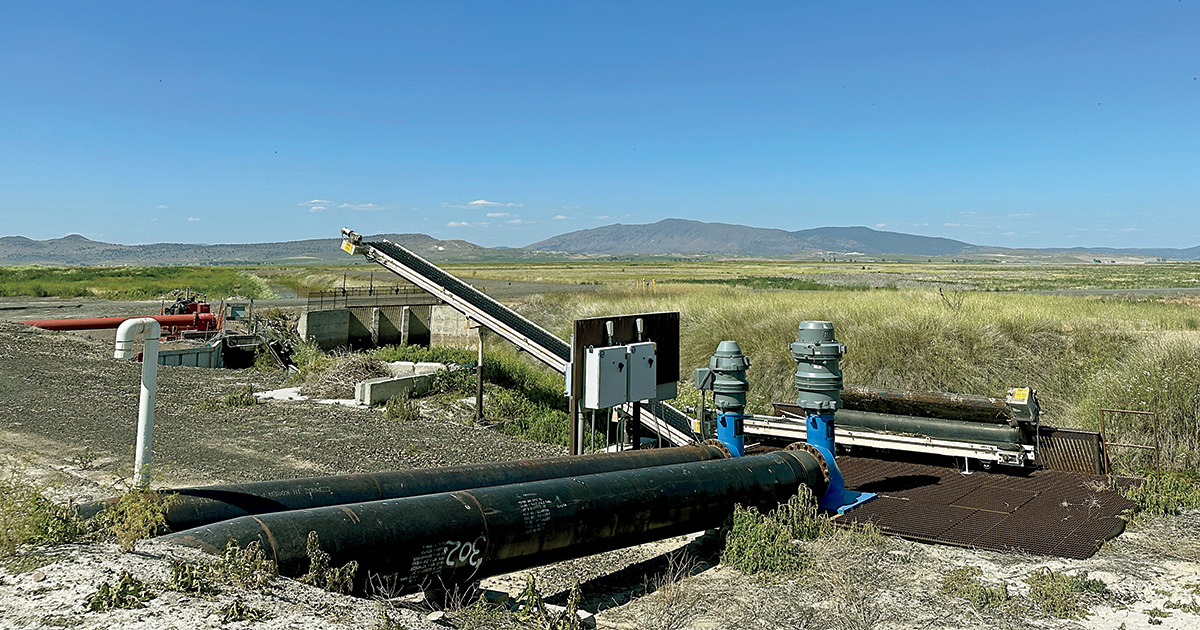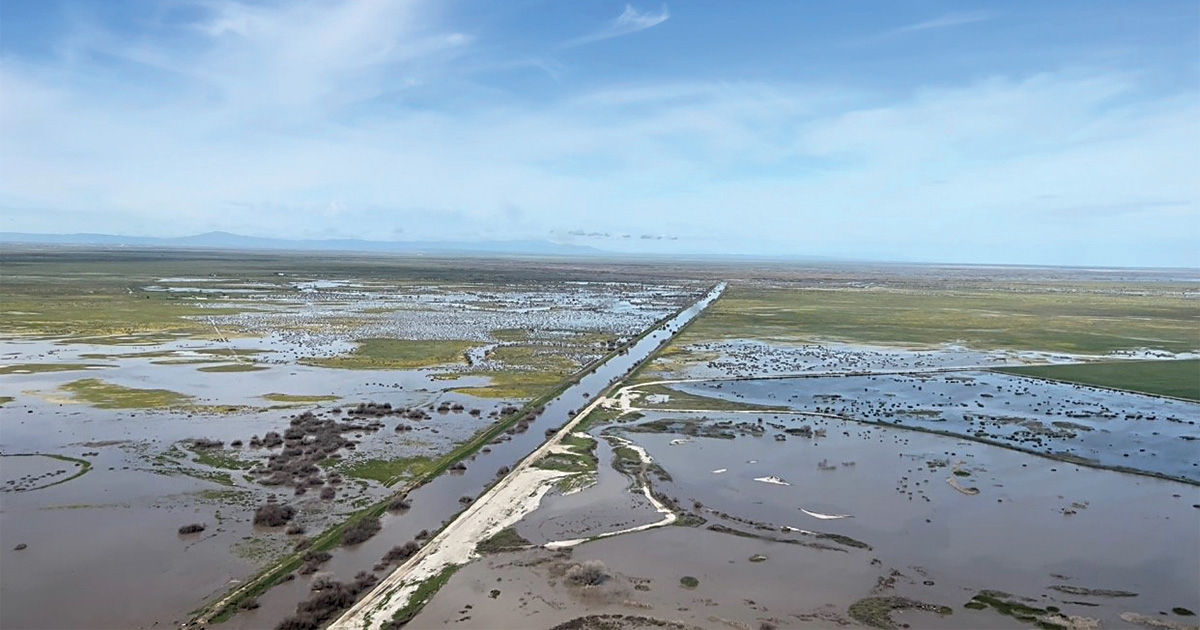Conservation: Making Every Drop Count
Wetlands play a vital role in conserving and managing California’s precious water resources
Wetlands play a vital role in conserving and managing California’s precious water resources
By Jennifer Boudart

Leonardo da Vinci once said, “Water is the driving force of all nature.” This sentiment certainly rings true in California, where it might be said that water is the driving force of everything. “The economy, society, and, in many ways civilization as we know it—not just in California but in most of the West—all depend on how people make decisions around the use of water,” observes Jeff McCreary, director of operations in DU’s Western Region.
“All water users—agriculture, municipalities, wildlife areas—exist in the same crowded landscape and compete for the same drop of water, which is mainly surface water,” McCreary adds. “Somewhere in that mix, DU must find ways to make sure that waterfowl get the resources they need to sustain themselves. DU must build innovative partnerships to make every drop of water go as far as it possibly can.”
That’s mission critical in what McCreary calls a new water era in California, one marked by growing demands for water amid increasingly unpredictable cycles of wet and dry weather. This kind of unpredictability was on display earlier this year, when a three-year cycle of record-breaking drought ended with record-breaking winter rains and snowfall. Thanks to DU’s work throughout California, wetlands are helping to conserve and manage water supplies in times of both drought and deluge by providing a host of benefits for waterfowl, wildlife, and people.
Gray Lodge Wildlife Area is located in the Sacramento Valley and supports as many as 1 million ducks and 200,000 geese each winter. Tens of thousands of people visit the refuge annually to hunt, fish, hike, and enjoy wildlife viewing and photography. Gray Lodge sits at the tail end of an irrigation system that must also supply water for users who grow rice as well as various nut and fruit crops. Because of this, before this year Gray Lodge consistently failed to receive its legally mandated water for wetland management.
Ongoing struggles regarding the timing and volume of water deliveries highlighted the need for an extensive overhaul of Gray Lodge’s canals and levees. As part of a $52 million infrastructure project completed earlier this year, DU helped make that overhaul happen in partnership with the US Bureau of Reclamation, California Department of Fish and Wildlife, and Biggs–West Gridley Water District. Work involved upgrades to more than five miles of canals as well as improvements to infrastructure such as levees, water-control structures, and road and farm bridges. With these improvements, Gray Lodge will now receive its full allocation of water when it’s needed most to provide habitat for wintering waterfowl.

In 2022, DU installed a pumping station on the Lower Klamath National Wildlife Refuge, which allowed managers to flood a wetland unit on the refuge for migrating waterfowl this spring.
Rice fields in the Sacramento Valley provide an estimated 70 percent of the food resources that sustain waterfowl each winter. Those same rice fields are now being managed increasingly to benefit another species: the endangered Chinook salmon. Historically, out-migrating juvenile salmon relied on floodplain wetlands along the Sacramento River as they made their way toward the ocean. Today, the river is separated from its natural floodplain due to development. When the young fish move downriver in winter, there’s little food to sustain them in the sterile river channels. But there’s plenty of fish-friendly food nearby in the nutrient-rich waters of winter-flooded rice fields. It’s just a matter of making those resources available to the fish.
DU is partnering with the California Rice Commission, California Trout, and the Northern California Water Association to do just that. For its part, DU is developing a Decision Support Tool that will incorporate various layers of data to help rice growers release floodwaters from rice fields at key times and locations to benefit out-migrating salmon. Data layers will include locations of fish-bearing waterways, timing of juvenile fish passage, and reliability of water supplies for drawdowns and reflooding based on winter-flooding patterns within the Sacramento Valley.
Wetlands can also play a key role in storing floodwaters. Such is the case along the flood-prone San Joaquin River, which runs through the San Luis National Wildlife Refuge. DU recently delivered a floodplain reconnection project in the refuge’s East Bear Creek Unit, located in the Grassland Ecological Area (GEA). The largest intact complex of wetlands in the western United States, the 240,000-acre GEA supports millions of wintering waterfowl and other migratory birds each year.
The East Bear Creek project included infrastructure improvements that allow refuge managers to store floodwaters and move water between wetland units in a way that re-creates seasonal flooding patterns that once occurred there naturally. The project expands the footprint of flooded wetlands that provide habitat for waterfowl, divert floodwaters away from downstream communities, and help recharge a local aquifer that serves as an important water supply, especially in times of drought. DU’s partners in this project included the US Fish and Wildlife Service (USFWS) and PepsiCo North America, which supports projects like East Bear Creek as part of its effort to become net water positive by 2030. The company aims to reduce absolute water use and replenish more than 100 percent of the water used at PepsiCo-owned and affiliated sites in high-water-risk areas.
Located along the California-Oregon border, the Klamath Basin typically hosts approximately 80 percent of the Pacific Flyway’s waterfowl at various times. The basin is home to the Lower Klamath and Tule Lake National Wildlife Refuges. Unfortunately, the combined effects of drought and years of dwindling water allocations caused both refuges to go completely dry last year—the first time since they were established over 100 years ago. And they remain almost completely dry this year despite the wet winter.

In addition to providing crucial habitat for fish and wildlife, many DU projects are designed to store floodwaters diverted from nearby rivers, protecting downstream communities and agricultural lands.
There was one bright spot to celebrate: A pumping station DU installed in 2022 enabled managers to fill Unit 2 on the Lower Klamath refuge earlier this spring. The pumping station, located along the Straits Drain, makes it possible to re-use water within the refuge as well as water secured in cooperation with the Klamath Drainage District and private landowners. Project partners included the North American Wetlands Conservation Act, USFWS, and Cal-Ore Wetlands and Waterfowl Council. DU has received $2.6 million to install two additional pumping stations on each refuge through the Bipartisan Infrastructure Law, which allocates nearly $26 million for Klamath Basin restoration projects. Additional work is planned thanks to more than $1 million in commitments DU has received through its Klamath Basin Initiative, which was launched in 2021.
In California, water-related conservation is primarily supported by “water bonds,” such as the $7.5 billion Water Quality, Supply, and Infrastructure Improvement Act of 2014 (Proposition 1). Another water bond is set to go to voters as soon as next year, and McCreary believes it will have public support. “In the West, reliance on water is on most people’s minds,” he says. “They’re educated about the value of investing in water bonds as well as the functions wetlands offer. They have seen how wetlands can keep floodwaters from ending up in their houses. And people who have experienced turning on the tap and not having water are appreciating that wetlands can recharge their aquifer.”
Ducks Unlimited uses cookies to enhance your browsing experience, optimize site functionality, analyze traffic, and deliver personalized advertising through third parties. By continuing to use this site, you agree to our use of cookies. View Privacy Policy